Student Assignment: Implement and Monitor Care for Acute Problems
VerifiedAdded on 2022/10/17
|26
|4927
|9
Homework Assignment
AI Summary
This student assignment addresses the implementation and monitoring of care for individuals experiencing acute health problems. The assignment begins by exploring the etiology and clinical features of various acute conditions, including acute kidney injury, gastrointestinal disorders, ischemic stroke, complex regional pain syndrome, asthma, and more. The assignment further covers nursing interventions such as assessment, planning, implementation, and evaluation of care using a nursing model or framework. The assignment also delves into specific nursing care aspects, including managing fluid and electrolyte balance, nutrition, pain, infection control, wound care, stress, anxiety, and altered body image. The assignment then touches on surgical procedures, pre- and post-operative care, and specific interventions like intravenous fluid intake, central venous catheters, antibiotic therapy, and total parenteral nutrition. Additional topics include pre- and post-anesthetic considerations, the function and complications of PICC lines, pain management strategies, Glasgow Coma Scale assessment, respiratory arrest, and pulmonary embolism. Finally, the assignment covers topics such as acute pancreatitis and airway management, including nursing interventions. The assignment provides a comprehensive overview of various acute health problems and the nursing care required for effective patient management.

Running Head: IMP AND MON CARE
0
Implement and monitor care
student
7/25/2019
0
Implement and monitor care
student
7/25/2019
Paraphrase This Document
Need a fresh take? Get an instant paraphrase of this document with our AI Paraphraser

IMP AND MON CARE
1
Answer (Q1);
health issue Etiology Clinical features
acute kidney
injury
Kidney injury or AKI is commonly caused when the
kidneys are injured unexpectedly. The damage may be
caused by insufficient blood flowing by the kidneys, an
injury directly caused to the kidneys or the issue with
the kidneys. A blockage in the uterus, the ducts that
transport the urine form the kidneys to the bladder
Not enough urine,
swelling in the legs,
ankles or feet (Zuk, &
Bonventre, 2016).
Acute
gastrointestinal
disorders
A number of dissimilar situations or diseases can
impact the Gastrointestinal tract and have an influence
on food digestion and/or the overall health of the
patient. Some of the condition that can affect GI
include celiac, disease, constipation, diarrhoea,
Crohn’s disease, GERD, diverticular, vomiting etc.
Bleeding, Bloating,
Constipation, Diarrhea,
Heartburn,
Incontinence, and
Nausea and vomiting
Ischemic stroke the ischemic stroke happens because of atherosclerosis,
which further causes fatty deposits and the
establishment of cholesterol plaque inside the blood
vessels
Face dropping, arm
weakness, speak issues
etc.
Complex
regional pain
syndrome
(CRPS)
The disorder is activated by a strong history of trauma
or harm. The most shared activators are fractures,
sprains/strains, injury to soft tissue, immobilization of
limb, operation, or even small medical processes for
example needle stick.
Constant pain, changes
in skin texture,
abnormal sweating
pattern, and stiffness in
pretentious joints
Asthma Asthma is a disorder in which the airways contracted Shortness of breath,
1
Answer (Q1);
health issue Etiology Clinical features
acute kidney
injury
Kidney injury or AKI is commonly caused when the
kidneys are injured unexpectedly. The damage may be
caused by insufficient blood flowing by the kidneys, an
injury directly caused to the kidneys or the issue with
the kidneys. A blockage in the uterus, the ducts that
transport the urine form the kidneys to the bladder
Not enough urine,
swelling in the legs,
ankles or feet (Zuk, &
Bonventre, 2016).
Acute
gastrointestinal
disorders
A number of dissimilar situations or diseases can
impact the Gastrointestinal tract and have an influence
on food digestion and/or the overall health of the
patient. Some of the condition that can affect GI
include celiac, disease, constipation, diarrhoea,
Crohn’s disease, GERD, diverticular, vomiting etc.
Bleeding, Bloating,
Constipation, Diarrhea,
Heartburn,
Incontinence, and
Nausea and vomiting
Ischemic stroke the ischemic stroke happens because of atherosclerosis,
which further causes fatty deposits and the
establishment of cholesterol plaque inside the blood
vessels
Face dropping, arm
weakness, speak issues
etc.
Complex
regional pain
syndrome
(CRPS)
The disorder is activated by a strong history of trauma
or harm. The most shared activators are fractures,
sprains/strains, injury to soft tissue, immobilization of
limb, operation, or even small medical processes for
example needle stick.
Constant pain, changes
in skin texture,
abnormal sweating
pattern, and stiffness in
pretentious joints
Asthma Asthma is a disorder in which the airways contracted Shortness of breath,
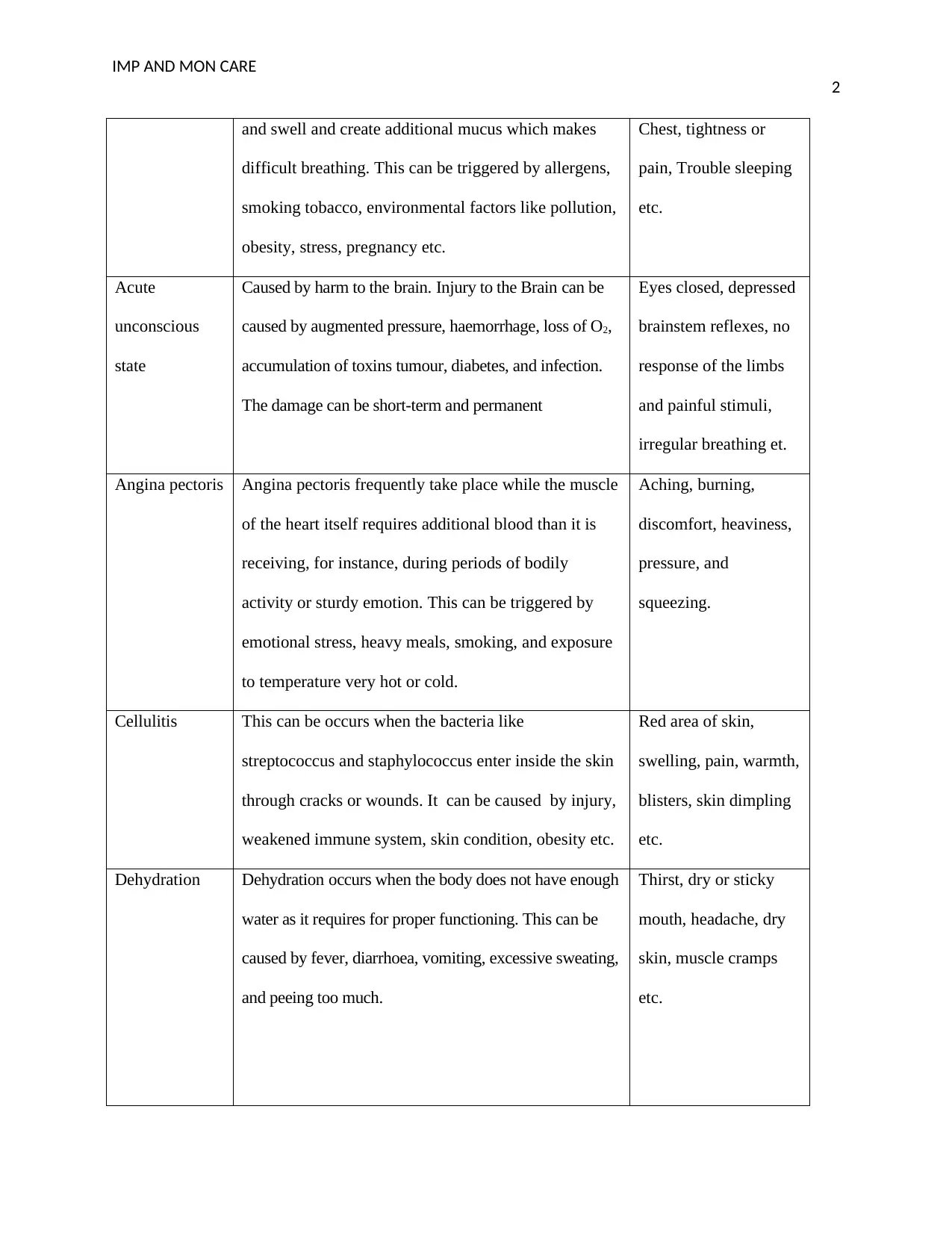
IMP AND MON CARE
2
and swell and create additional mucus which makes
difficult breathing. This can be triggered by allergens,
smoking tobacco, environmental factors like pollution,
obesity, stress, pregnancy etc.
Chest, tightness or
pain, Trouble sleeping
etc.
Acute
unconscious
state
Caused by harm to the brain. Injury to the Brain can be
caused by augmented pressure, haemorrhage, loss of O2,
accumulation of toxins tumour, diabetes, and infection.
The damage can be short-term and permanent
Eyes closed, depressed
brainstem reflexes, no
response of the limbs
and painful stimuli,
irregular breathing et.
Angina pectoris Angina pectoris frequently take place while the muscle
of the heart itself requires additional blood than it is
receiving, for instance, during periods of bodily
activity or sturdy emotion. This can be triggered by
emotional stress, heavy meals, smoking, and exposure
to temperature very hot or cold.
Aching, burning,
discomfort, heaviness,
pressure, and
squeezing.
Cellulitis This can be occurs when the bacteria like
streptococcus and staphylococcus enter inside the skin
through cracks or wounds. It can be caused by injury,
weakened immune system, skin condition, obesity etc.
Red area of skin,
swelling, pain, warmth,
blisters, skin dimpling
etc.
Dehydration Dehydration occurs when the body does not have enough
water as it requires for proper functioning. This can be
caused by fever, diarrhoea, vomiting, excessive sweating,
and peeing too much.
Thirst, dry or sticky
mouth, headache, dry
skin, muscle cramps
etc.
2
and swell and create additional mucus which makes
difficult breathing. This can be triggered by allergens,
smoking tobacco, environmental factors like pollution,
obesity, stress, pregnancy etc.
Chest, tightness or
pain, Trouble sleeping
etc.
Acute
unconscious
state
Caused by harm to the brain. Injury to the Brain can be
caused by augmented pressure, haemorrhage, loss of O2,
accumulation of toxins tumour, diabetes, and infection.
The damage can be short-term and permanent
Eyes closed, depressed
brainstem reflexes, no
response of the limbs
and painful stimuli,
irregular breathing et.
Angina pectoris Angina pectoris frequently take place while the muscle
of the heart itself requires additional blood than it is
receiving, for instance, during periods of bodily
activity or sturdy emotion. This can be triggered by
emotional stress, heavy meals, smoking, and exposure
to temperature very hot or cold.
Aching, burning,
discomfort, heaviness,
pressure, and
squeezing.
Cellulitis This can be occurs when the bacteria like
streptococcus and staphylococcus enter inside the skin
through cracks or wounds. It can be caused by injury,
weakened immune system, skin condition, obesity etc.
Red area of skin,
swelling, pain, warmth,
blisters, skin dimpling
etc.
Dehydration Dehydration occurs when the body does not have enough
water as it requires for proper functioning. This can be
caused by fever, diarrhoea, vomiting, excessive sweating,
and peeing too much.
Thirst, dry or sticky
mouth, headache, dry
skin, muscle cramps
etc.
⊘ This is a preview!⊘
Do you want full access?
Subscribe today to unlock all pages.

Trusted by 1+ million students worldwide

IMP AND MON CARE
3
Hemorrhagic
shock
Hemorrhagic shock is the illness of decreased tissue
perfusion, leads the insufficient delivery of O2 and
necessary nutrients for cellular function. This can be
caused by heavy bleeding, heart down and failure to
transport blood.
Weakness, fatigue,
fainting and dizziness.
concussion A powerful blow to the head and neck or the superior
body can cause the brain to slip back and forward
powerfully against the internal walls of the skull.
Sudden hastening or slowing of the head that is caused
by incidents like a car accident or being brutally
shaken likewise can cause the brain damage. These
injuries impacts functioning of brain, commonly for a
short period, leads to concussion related signs and
symptoms.
Memory issue,
confusion, dizziness,
headache, balance
problems, slowed
reaction to the stimuli
etc.
Myocardial
infarction
Myocardial infarction happens when a coronary
arteries of the heart is obstructed unexpectedly or has
exceedingly slow transport of blood movement. Main
cause of sudden obstruction is the development of a
blood clot also called thrombus.
Chest pain, pressing,
squeezing, crushing,
burning etc.
Nephrolithiasis Nephrolithiasis denotes to the existence of crystalline
stones inside patient’s urinary system that are form
from microscopic crystals within loop of Henle, the
distal tubules, or a collecting vessel. Causes due to
elevated intensities of urinary solutes for example
calcium, uric acid, oxalate, and the sodium, in addition
Pain associated with
back, belly or sides,
pain and bruising
during urination,
fever/chills, vomiting
etc.
3
Hemorrhagic
shock
Hemorrhagic shock is the illness of decreased tissue
perfusion, leads the insufficient delivery of O2 and
necessary nutrients for cellular function. This can be
caused by heavy bleeding, heart down and failure to
transport blood.
Weakness, fatigue,
fainting and dizziness.
concussion A powerful blow to the head and neck or the superior
body can cause the brain to slip back and forward
powerfully against the internal walls of the skull.
Sudden hastening or slowing of the head that is caused
by incidents like a car accident or being brutally
shaken likewise can cause the brain damage. These
injuries impacts functioning of brain, commonly for a
short period, leads to concussion related signs and
symptoms.
Memory issue,
confusion, dizziness,
headache, balance
problems, slowed
reaction to the stimuli
etc.
Myocardial
infarction
Myocardial infarction happens when a coronary
arteries of the heart is obstructed unexpectedly or has
exceedingly slow transport of blood movement. Main
cause of sudden obstruction is the development of a
blood clot also called thrombus.
Chest pain, pressing,
squeezing, crushing,
burning etc.
Nephrolithiasis Nephrolithiasis denotes to the existence of crystalline
stones inside patient’s urinary system that are form
from microscopic crystals within loop of Henle, the
distal tubules, or a collecting vessel. Causes due to
elevated intensities of urinary solutes for example
calcium, uric acid, oxalate, and the sodium, in addition
Pain associated with
back, belly or sides,
pain and bruising
during urination,
fever/chills, vomiting
etc.
Paraphrase This Document
Need a fresh take? Get an instant paraphrase of this document with our AI Paraphraser
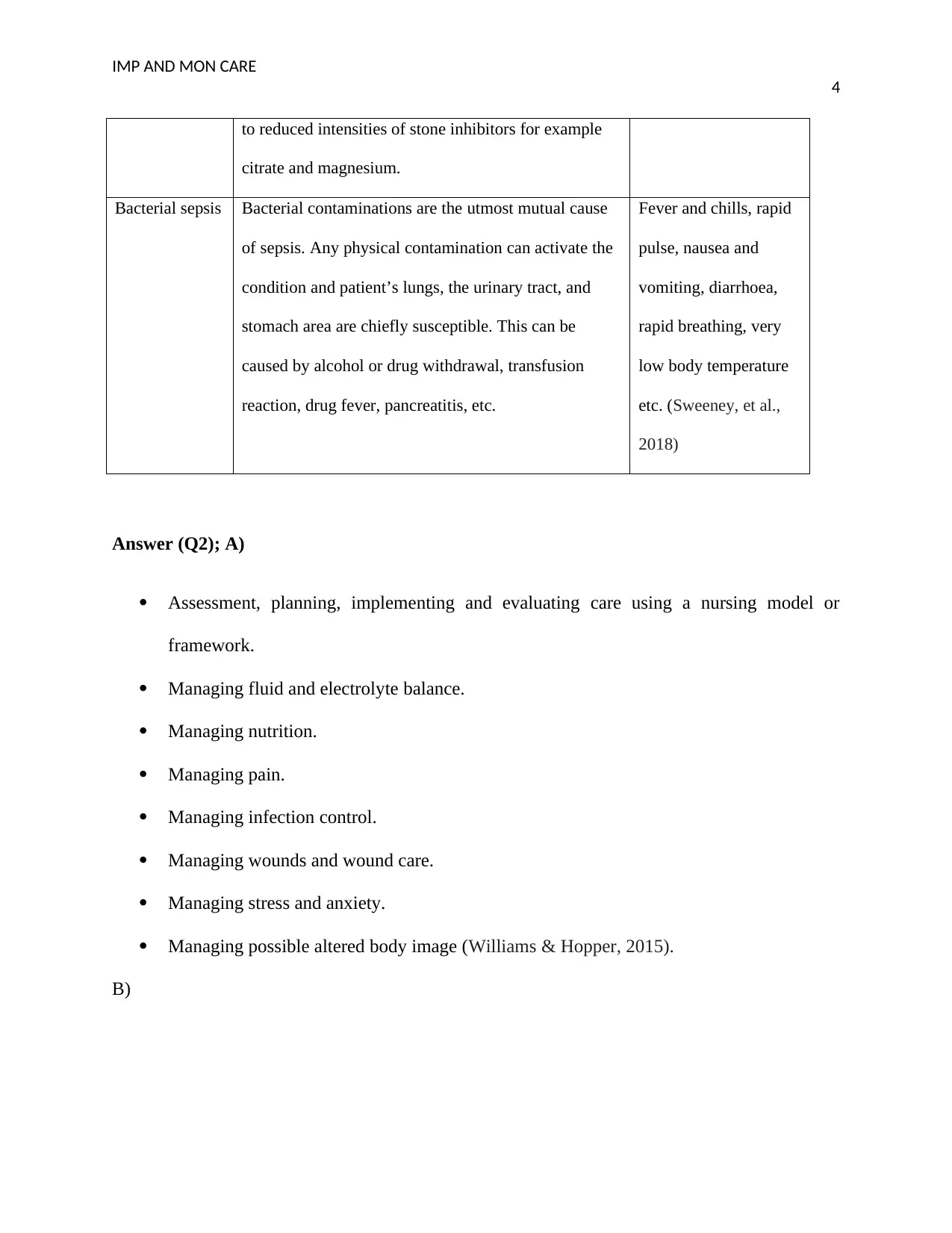
IMP AND MON CARE
4
to reduced intensities of stone inhibitors for example
citrate and magnesium.
Bacterial sepsis Bacterial contaminations are the utmost mutual cause
of sepsis. Any physical contamination can activate the
condition and patient’s lungs, the urinary tract, and
stomach area are chiefly susceptible. This can be
caused by alcohol or drug withdrawal, transfusion
reaction, drug fever, pancreatitis, etc.
Fever and chills, rapid
pulse, nausea and
vomiting, diarrhoea,
rapid breathing, very
low body temperature
etc. (Sweeney, et al.,
2018)
Answer (Q2); A)
Assessment, planning, implementing and evaluating care using a nursing model or
framework.
Managing fluid and electrolyte balance.
Managing nutrition.
Managing pain.
Managing infection control.
Managing wounds and wound care.
Managing stress and anxiety.
Managing possible altered body image (Williams & Hopper, 2015).
B)
4
to reduced intensities of stone inhibitors for example
citrate and magnesium.
Bacterial sepsis Bacterial contaminations are the utmost mutual cause
of sepsis. Any physical contamination can activate the
condition and patient’s lungs, the urinary tract, and
stomach area are chiefly susceptible. This can be
caused by alcohol or drug withdrawal, transfusion
reaction, drug fever, pancreatitis, etc.
Fever and chills, rapid
pulse, nausea and
vomiting, diarrhoea,
rapid breathing, very
low body temperature
etc. (Sweeney, et al.,
2018)
Answer (Q2); A)
Assessment, planning, implementing and evaluating care using a nursing model or
framework.
Managing fluid and electrolyte balance.
Managing nutrition.
Managing pain.
Managing infection control.
Managing wounds and wound care.
Managing stress and anxiety.
Managing possible altered body image (Williams & Hopper, 2015).
B)
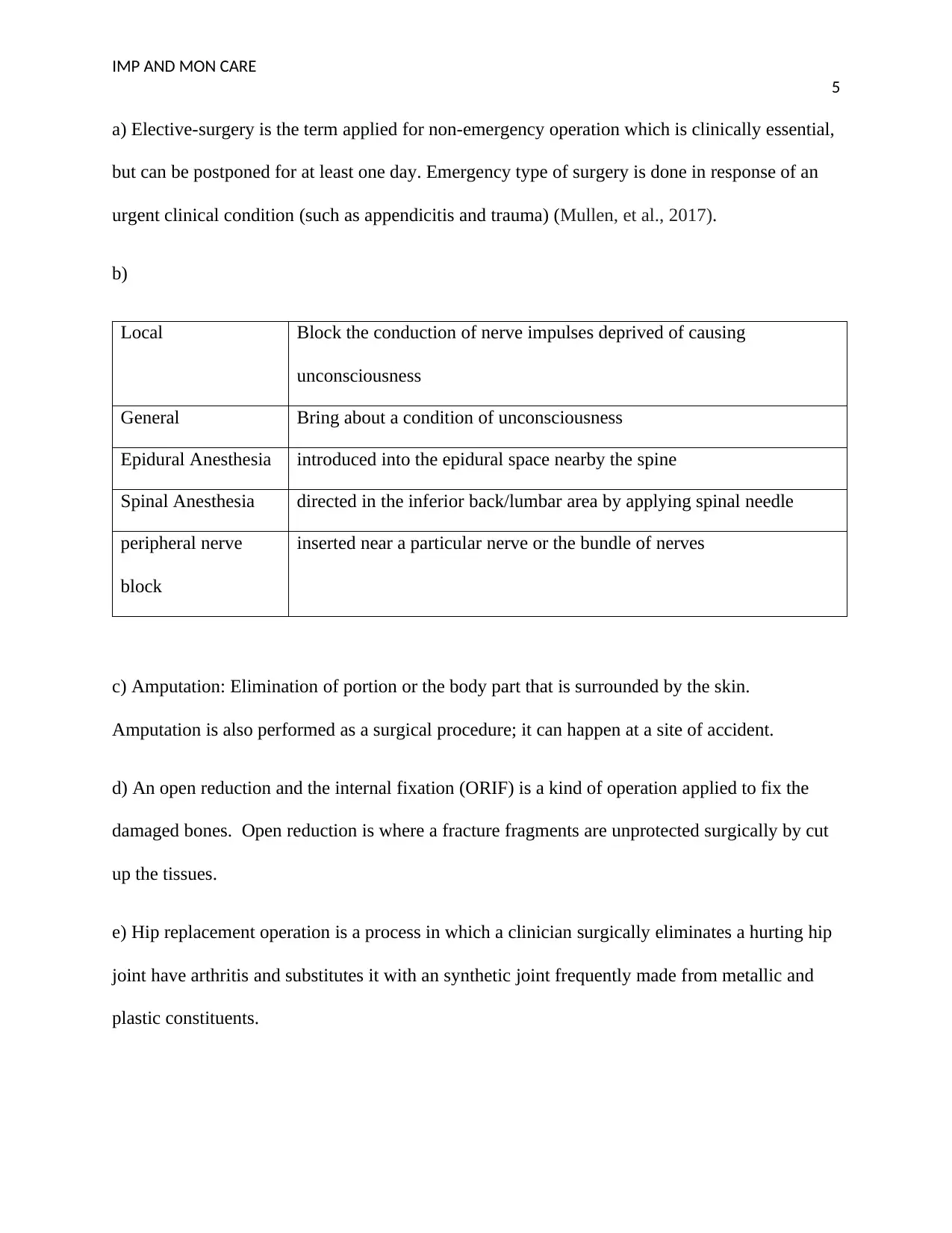
IMP AND MON CARE
5
a) Elective-surgery is the term applied for non-emergency operation which is clinically essential,
but can be postponed for at least one day. Emergency type of surgery is done in response of an
urgent clinical condition (such as appendicitis and trauma) (Mullen, et al., 2017).
b)
Local Block the conduction of nerve impulses deprived of causing
unconsciousness
General Bring about a condition of unconsciousness
Epidural Anesthesia introduced into the epidural space nearby the spine
Spinal Anesthesia directed in the inferior back/lumbar area by applying spinal needle
peripheral nerve
block
inserted near a particular nerve or the bundle of nerves
c) Amputation: Elimination of portion or the body part that is surrounded by the skin.
Amputation is also performed as a surgical procedure; it can happen at a site of accident.
d) An open reduction and the internal fixation (ORIF) is a kind of operation applied to fix the
damaged bones. Open reduction is where a fracture fragments are unprotected surgically by cut
up the tissues.
e) Hip replacement operation is a process in which a clinician surgically eliminates a hurting hip
joint have arthritis and substitutes it with an synthetic joint frequently made from metallic and
plastic constituents.
5
a) Elective-surgery is the term applied for non-emergency operation which is clinically essential,
but can be postponed for at least one day. Emergency type of surgery is done in response of an
urgent clinical condition (such as appendicitis and trauma) (Mullen, et al., 2017).
b)
Local Block the conduction of nerve impulses deprived of causing
unconsciousness
General Bring about a condition of unconsciousness
Epidural Anesthesia introduced into the epidural space nearby the spine
Spinal Anesthesia directed in the inferior back/lumbar area by applying spinal needle
peripheral nerve
block
inserted near a particular nerve or the bundle of nerves
c) Amputation: Elimination of portion or the body part that is surrounded by the skin.
Amputation is also performed as a surgical procedure; it can happen at a site of accident.
d) An open reduction and the internal fixation (ORIF) is a kind of operation applied to fix the
damaged bones. Open reduction is where a fracture fragments are unprotected surgically by cut
up the tissues.
e) Hip replacement operation is a process in which a clinician surgically eliminates a hurting hip
joint have arthritis and substitutes it with an synthetic joint frequently made from metallic and
plastic constituents.
⊘ This is a preview!⊘
Do you want full access?
Subscribe today to unlock all pages.

Trusted by 1+ million students worldwide
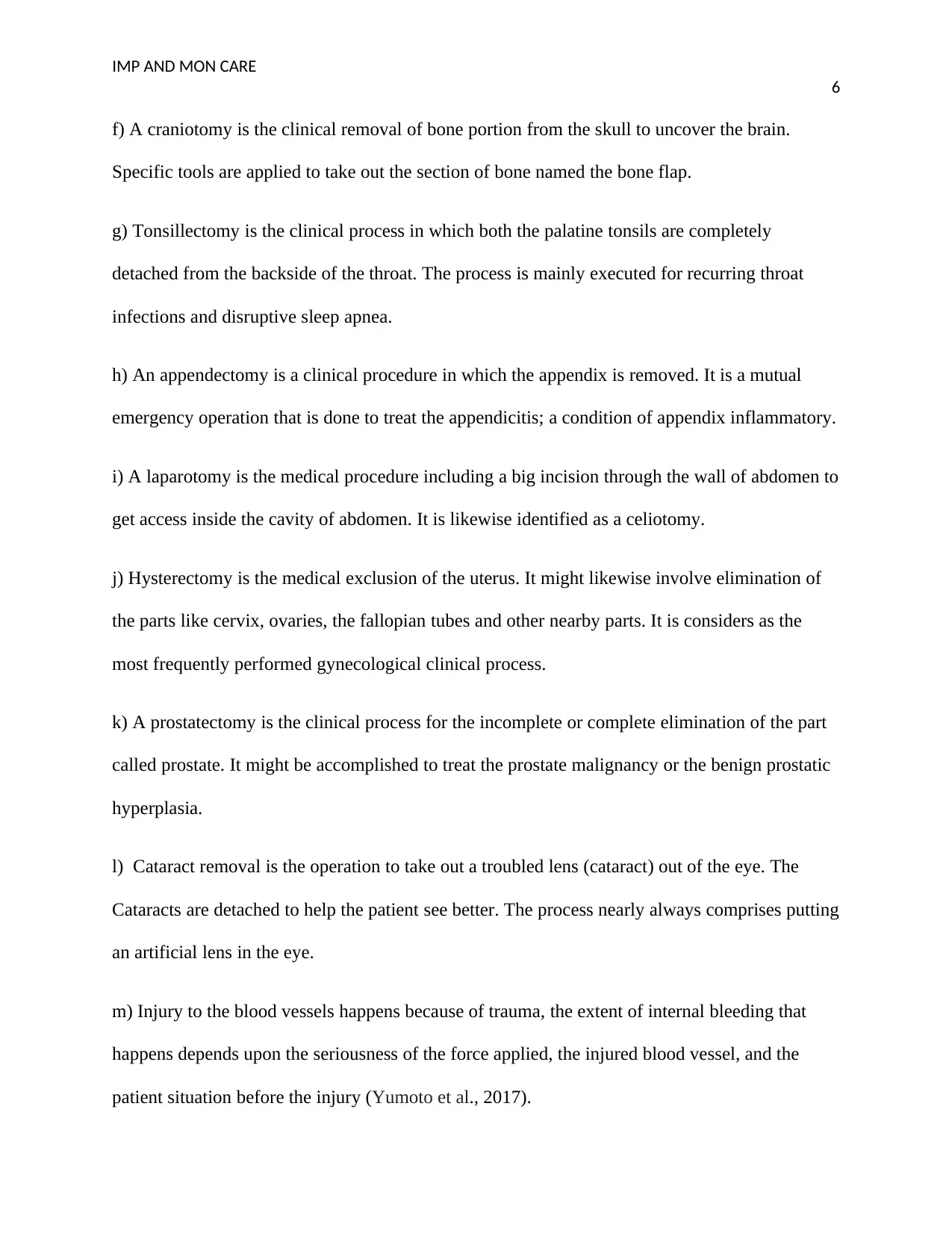
IMP AND MON CARE
6
f) A craniotomy is the clinical removal of bone portion from the skull to uncover the brain.
Specific tools are applied to take out the section of bone named the bone flap.
g) Tonsillectomy is the clinical process in which both the palatine tonsils are completely
detached from the backside of the throat. The process is mainly executed for recurring throat
infections and disruptive sleep apnea.
h) An appendectomy is a clinical procedure in which the appendix is removed. It is a mutual
emergency operation that is done to treat the appendicitis; a condition of appendix inflammatory.
i) A laparotomy is the medical procedure including a big incision through the wall of abdomen to
get access inside the cavity of abdomen. It is likewise identified as a celiotomy.
j) Hysterectomy is the medical exclusion of the uterus. It might likewise involve elimination of
the parts like cervix, ovaries, the fallopian tubes and other nearby parts. It is considers as the
most frequently performed gynecological clinical process.
k) A prostatectomy is the clinical process for the incomplete or complete elimination of the part
called prostate. It might be accomplished to treat the prostate malignancy or the benign prostatic
hyperplasia.
l) Cataract removal is the operation to take out a troubled lens (cataract) out of the eye. The
Cataracts are detached to help the patient see better. The process nearly always comprises putting
an artificial lens in the eye.
m) Injury to the blood vessels happens because of trauma, the extent of internal bleeding that
happens depends upon the seriousness of the force applied, the injured blood vessel, and the
patient situation before the injury (Yumoto et al., 2017).
6
f) A craniotomy is the clinical removal of bone portion from the skull to uncover the brain.
Specific tools are applied to take out the section of bone named the bone flap.
g) Tonsillectomy is the clinical process in which both the palatine tonsils are completely
detached from the backside of the throat. The process is mainly executed for recurring throat
infections and disruptive sleep apnea.
h) An appendectomy is a clinical procedure in which the appendix is removed. It is a mutual
emergency operation that is done to treat the appendicitis; a condition of appendix inflammatory.
i) A laparotomy is the medical procedure including a big incision through the wall of abdomen to
get access inside the cavity of abdomen. It is likewise identified as a celiotomy.
j) Hysterectomy is the medical exclusion of the uterus. It might likewise involve elimination of
the parts like cervix, ovaries, the fallopian tubes and other nearby parts. It is considers as the
most frequently performed gynecological clinical process.
k) A prostatectomy is the clinical process for the incomplete or complete elimination of the part
called prostate. It might be accomplished to treat the prostate malignancy or the benign prostatic
hyperplasia.
l) Cataract removal is the operation to take out a troubled lens (cataract) out of the eye. The
Cataracts are detached to help the patient see better. The process nearly always comprises putting
an artificial lens in the eye.
m) Injury to the blood vessels happens because of trauma, the extent of internal bleeding that
happens depends upon the seriousness of the force applied, the injured blood vessel, and the
patient situation before the injury (Yumoto et al., 2017).
Paraphrase This Document
Need a fresh take? Get an instant paraphrase of this document with our AI Paraphraser
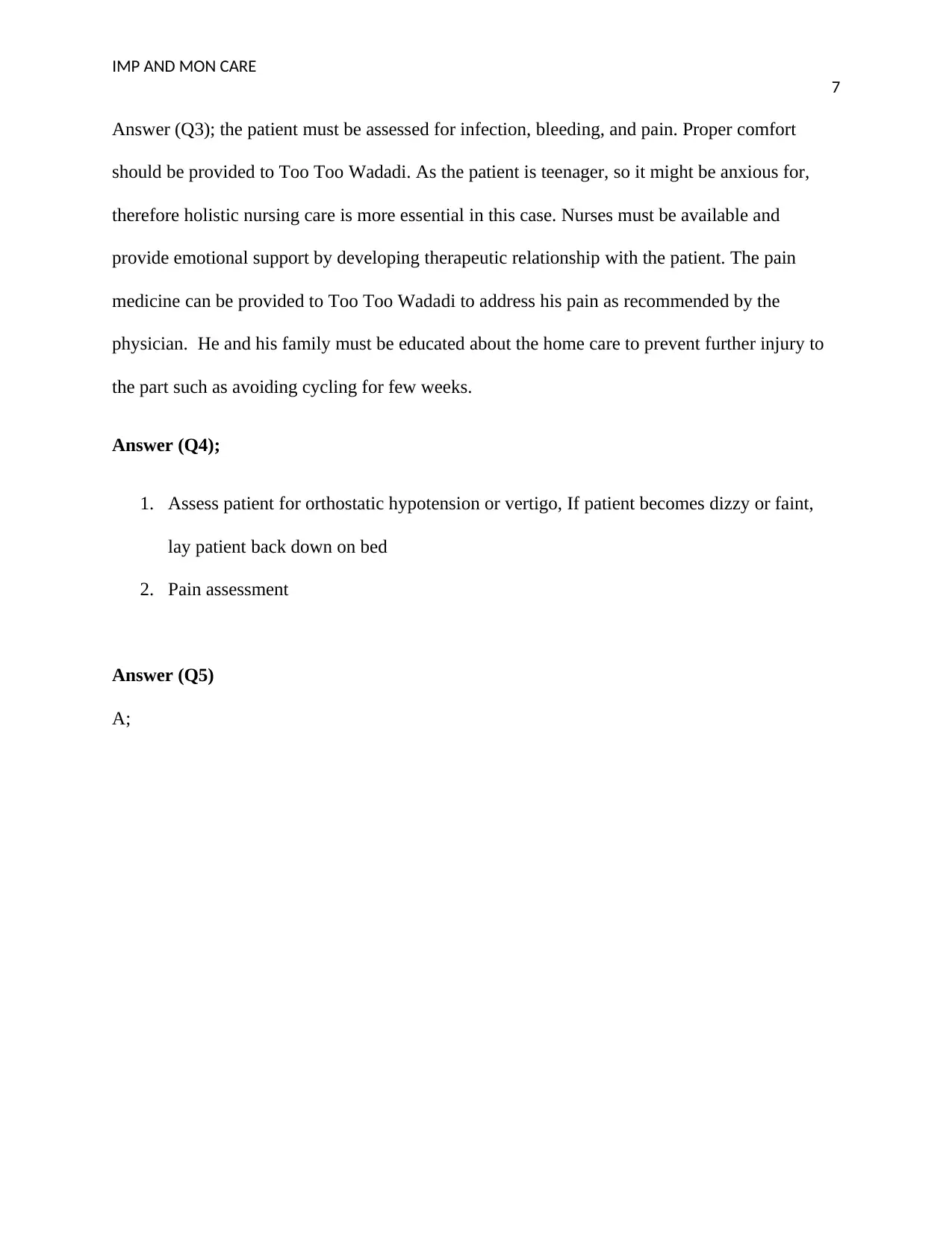
IMP AND MON CARE
7
Answer (Q3); the patient must be assessed for infection, bleeding, and pain. Proper comfort
should be provided to Too Too Wadadi. As the patient is teenager, so it might be anxious for,
therefore holistic nursing care is more essential in this case. Nurses must be available and
provide emotional support by developing therapeutic relationship with the patient. The pain
medicine can be provided to Too Too Wadadi to address his pain as recommended by the
physician. He and his family must be educated about the home care to prevent further injury to
the part such as avoiding cycling for few weeks.
Answer (Q4);
1. Assess patient for orthostatic hypotension or vertigo, If patient becomes dizzy or faint,
lay patient back down on bed
2. Pain assessment
Answer (Q5)
A;
7
Answer (Q3); the patient must be assessed for infection, bleeding, and pain. Proper comfort
should be provided to Too Too Wadadi. As the patient is teenager, so it might be anxious for,
therefore holistic nursing care is more essential in this case. Nurses must be available and
provide emotional support by developing therapeutic relationship with the patient. The pain
medicine can be provided to Too Too Wadadi to address his pain as recommended by the
physician. He and his family must be educated about the home care to prevent further injury to
the part such as avoiding cycling for few weeks.
Answer (Q4);
1. Assess patient for orthostatic hypotension or vertigo, If patient becomes dizzy or faint,
lay patient back down on bed
2. Pain assessment
Answer (Q5)
A;
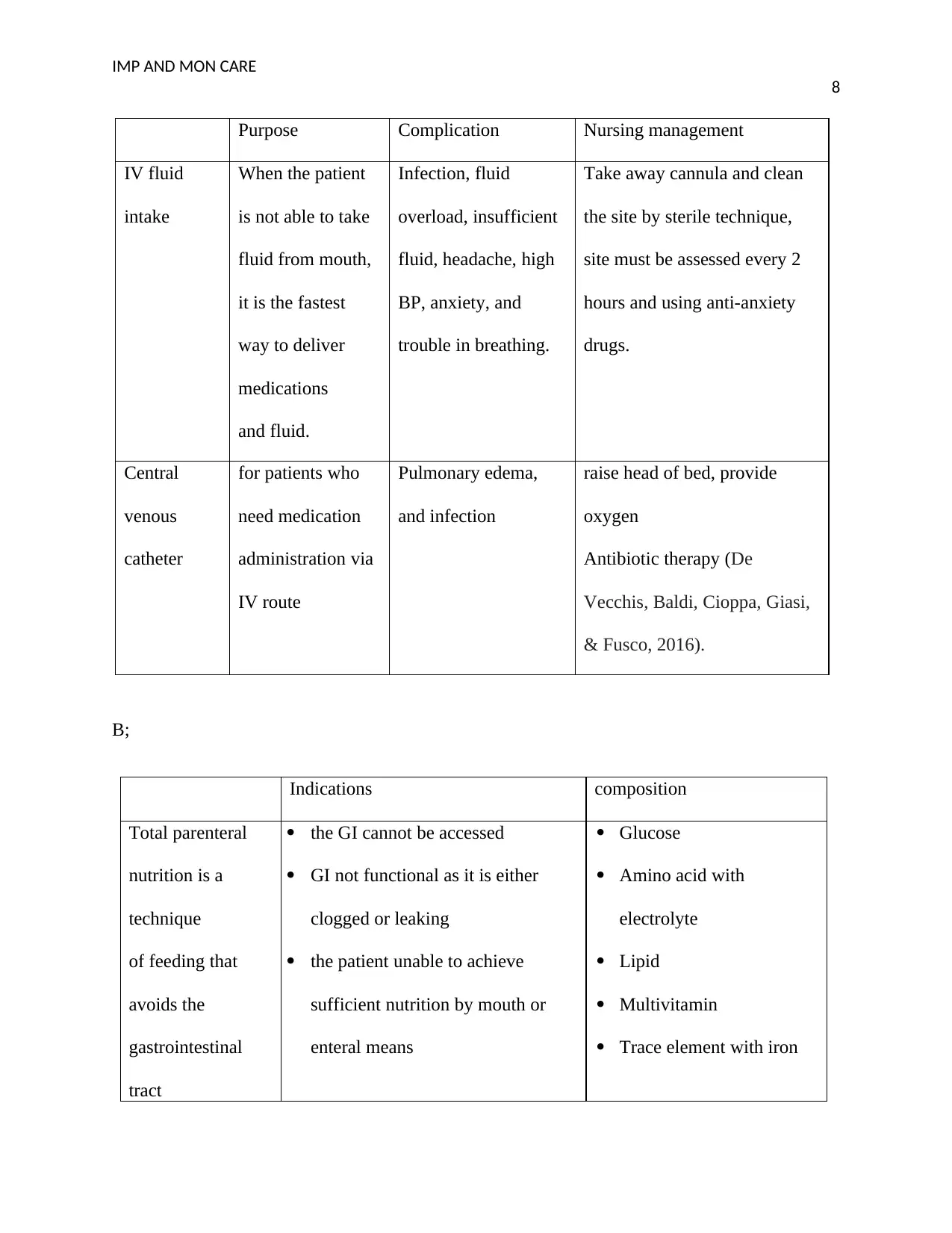
IMP AND MON CARE
8
Purpose Complication Nursing management
IV fluid
intake
When the patient
is not able to take
fluid from mouth,
it is the fastest
way to deliver
medications
and fluid.
Infection, fluid
overload, insufficient
fluid, headache, high
BP, anxiety, and
trouble in breathing.
Take away cannula and clean
the site by sterile technique,
site must be assessed every 2
hours and using anti-anxiety
drugs.
Central
venous
catheter
for patients who
need medication
administration via
IV route
Pulmonary edema,
and infection
raise head of bed, provide
oxygen
Antibiotic therapy (De
Vecchis, Baldi, Cioppa, Giasi,
& Fusco, 2016).
B;
Indications composition
Total parenteral
nutrition is a
technique
of feeding that
avoids the
gastrointestinal
tract
the GI cannot be accessed
GI not functional as it is either
clogged or leaking
the patient unable to achieve
sufficient nutrition by mouth or
enteral means
Glucose
Amino acid with
electrolyte
Lipid
Multivitamin
Trace element with iron
8
Purpose Complication Nursing management
IV fluid
intake
When the patient
is not able to take
fluid from mouth,
it is the fastest
way to deliver
medications
and fluid.
Infection, fluid
overload, insufficient
fluid, headache, high
BP, anxiety, and
trouble in breathing.
Take away cannula and clean
the site by sterile technique,
site must be assessed every 2
hours and using anti-anxiety
drugs.
Central
venous
catheter
for patients who
need medication
administration via
IV route
Pulmonary edema,
and infection
raise head of bed, provide
oxygen
Antibiotic therapy (De
Vecchis, Baldi, Cioppa, Giasi,
& Fusco, 2016).
B;
Indications composition
Total parenteral
nutrition is a
technique
of feeding that
avoids the
gastrointestinal
tract
the GI cannot be accessed
GI not functional as it is either
clogged or leaking
the patient unable to achieve
sufficient nutrition by mouth or
enteral means
Glucose
Amino acid with
electrolyte
Lipid
Multivitamin
Trace element with iron
⊘ This is a preview!⊘
Do you want full access?
Subscribe today to unlock all pages.

Trusted by 1+ million students worldwide
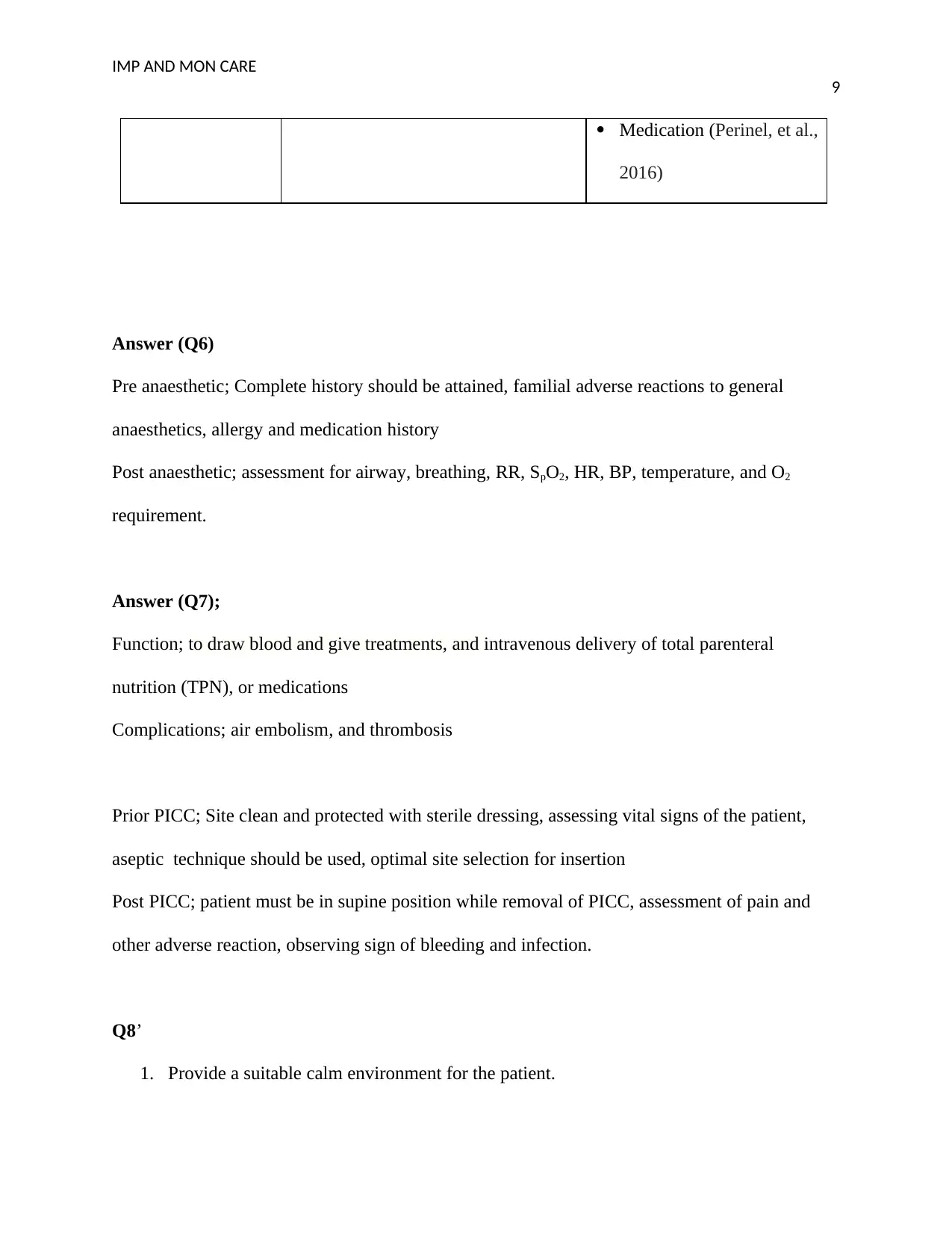
IMP AND MON CARE
9
Medication (Perinel, et al.,
2016)
Answer (Q6)
Pre anaesthetic; Complete history should be attained, familial adverse reactions to general
anaesthetics, allergy and medication history
Post anaesthetic; assessment for airway, breathing, RR, SpO2, HR, BP, temperature, and O2
requirement.
Answer (Q7);
Function; to draw blood and give treatments, and intravenous delivery of total parenteral
nutrition (TPN), or medications
Complications; air embolism, and thrombosis
Prior PICC; Site clean and protected with sterile dressing, assessing vital signs of the patient,
aseptic technique should be used, optimal site selection for insertion
Post PICC; patient must be in supine position while removal of PICC, assessment of pain and
other adverse reaction, observing sign of bleeding and infection.
Q8’
1. Provide a suitable calm environment for the patient.
9
Medication (Perinel, et al.,
2016)
Answer (Q6)
Pre anaesthetic; Complete history should be attained, familial adverse reactions to general
anaesthetics, allergy and medication history
Post anaesthetic; assessment for airway, breathing, RR, SpO2, HR, BP, temperature, and O2
requirement.
Answer (Q7);
Function; to draw blood and give treatments, and intravenous delivery of total parenteral
nutrition (TPN), or medications
Complications; air embolism, and thrombosis
Prior PICC; Site clean and protected with sterile dressing, assessing vital signs of the patient,
aseptic technique should be used, optimal site selection for insertion
Post PICC; patient must be in supine position while removal of PICC, assessment of pain and
other adverse reaction, observing sign of bleeding and infection.
Q8’
1. Provide a suitable calm environment for the patient.
Paraphrase This Document
Need a fresh take? Get an instant paraphrase of this document with our AI Paraphraser
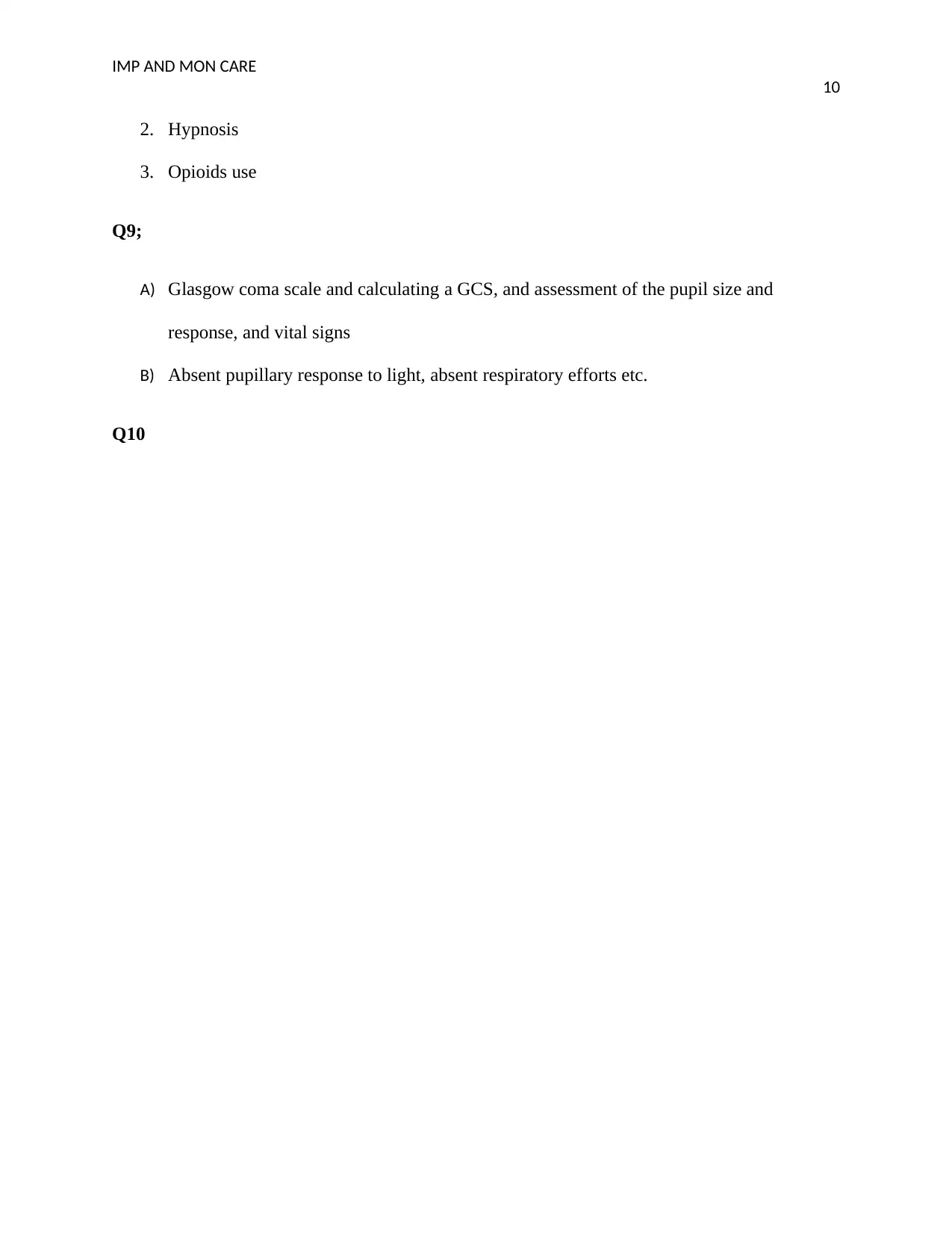
IMP AND MON CARE
10
2. Hypnosis
3. Opioids use
Q9;
A) Glasgow coma scale and calculating a GCS, and assessment of the pupil size and
response, and vital signs
B) Absent pupillary response to light, absent respiratory efforts etc.
Q10
10
2. Hypnosis
3. Opioids use
Q9;
A) Glasgow coma scale and calculating a GCS, and assessment of the pupil size and
response, and vital signs
B) Absent pupillary response to light, absent respiratory efforts etc.
Q10

IMP AND MON CARE
11
(Sources, De Caen et al., 2015)
Q11;
When an individual has respiratory arrest, 2 things take place: first CO2 is not removed
appropriately from the circulation, results in an accumulation of carbonic acid. The additional
11
(Sources, De Caen et al., 2015)
Q11;
When an individual has respiratory arrest, 2 things take place: first CO2 is not removed
appropriately from the circulation, results in an accumulation of carbonic acid. The additional
⊘ This is a preview!⊘
Do you want full access?
Subscribe today to unlock all pages.

Trusted by 1+ million students worldwide
1 out of 26
Related Documents
Your All-in-One AI-Powered Toolkit for Academic Success.
+13062052269
info@desklib.com
Available 24*7 on WhatsApp / Email
![[object Object]](/_next/static/media/star-bottom.7253800d.svg)
Unlock your academic potential
Copyright © 2020–2025 A2Z Services. All Rights Reserved. Developed and managed by ZUCOL.





